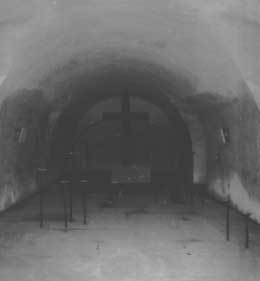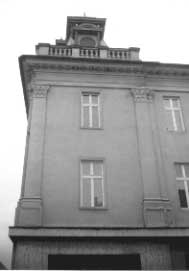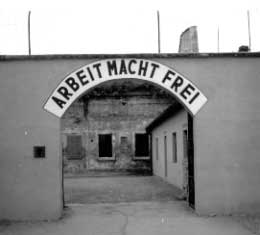The Trip to Terezin
Before we could start studying the Jewish community in Litomyšl, we had to find out about the lifestyle and history of the nation they came from and more or less claimed to belong to. We watched a CD-ROM from the Jewish Museum in Prague, we talked about what we had learned, we listened to Jewish songs, and finally we went to Terezín.
Our trip started on the morning on 10th October. We left school very early - at 6 a.m.
Emperor Joseph II had a fortress built between 1780-1790 to protect the access roads used by invading armies who wanted to get into central Bohemia. In 1941, a ghetto was created in the town. Germans brought Jews from the whole Protectorate of Bohemia and Moravia there. When it got so full that there was no more space left for them, the Germans gradually deported them to concentration camps, normally to Auschwitz.
When we arrived at the Magdeburg barracks, Mrs. Chládková invited us into what used to be the theatre, where we were shown a programme lasting the whole morning. We had prepared for the visit to Terezín at school. We watched a CD-ROM about the history, culture and religion of Jews in Czech lands. We also learned about the meaning of various terms and we filled in worksheets, so when we started to talk to Mrs. Chládková, we already knew a lot, but not nearly everything. First, the history of Jews came up and we talked mainly about what happened after Hitler came to power in Germany. Then we talked about Jewish feasts and we looked at pictures of various objects related to the Jewish religion. The most important words were written on the blackboard: shalom, purim, kipa, rosh ha shana, chanuka, tora, synagogue, rabbi, sabbath.
We watched a video about Terezín, then had a break to prepare tea or soup.
After lunch, Mr. Štulcová, our guide, took us for a tour round what used to be the ghetto. In fact, it used to be a concentration camp for Jews. They had to give all their possessions to the Germans and they were only allowed to take one piece of luggage weighing up to 50 kgs with them to Terezín. Jews were transported to the ghetto by trains, which stopped in Bohušovice, and people had to carry their luggage all the way to the ghetto. They had to walk for three kilometres. The railway was only extended to the town in 1943. Many prisoners were dead when the train arrived or died in great numbers shortly after arriving at Terezín. They were offered by something pretending to be coffee and a small piece of bread when they arrived. At first, Jewish prisoners were put into barracks and, until the middle of 1942, local people were forcibly moved away from Terezín. The whole of Terezín turned into a town behind bars. Parents were separated from children and men from women. The streets were marked by numbers and letters. More and more people were forced lived in the houses. In the museum, there is still one room furnished as it was at the time of the war. There are triple-decker beds made from planks of wood, plates, suitcases, and clothes.
The ghetto in Terezín was at first only going to be a camp where Jews from Moravia and Bohemia were sent either permanently or for a short time, but it became a ghetto for old prisoners from Germany and other countries occupied by Nazis too. Starting in April, 1945, 140,000 men, women, and children were deported to Terezín from the Czech lands, Germany, Austria, the Netherlands, Denmark, Slovakia and Hungary.
When we went back to the original theatre, we compared the transportation lists with the ones we had mentioning the Jews from Litomyšl. We collected all the important information, e.g. their transport numbers, how they left Terezín and where they were headed for. Then we also searched the commemorative book. We did not find all of the names.
At three o'clock. we left for the Small Fortress. It has served as a prison for military and political prisoners and also enemies of the Habsburg monarchy since the beginning of the 19th century. It became famous worldwide during the occupation of the Czech lands by the Nazis.
The prison was divided into four yards. In yard no. 1 there were 17 common cells and 20 singles, in yard no. 2, there were mainly places were prisoners worked, while no. 3 was the women's prison and no. 4 was the men's prison.
We saw mainly the first yard, because that was were Jews were imprisoned. The guide told us that the Small Fortress had never been heated. More than 100 prisoners had lived together in cells which were so crowded that people had to sleep standing up. Conditions were very bad. For example, Jews were always the last to be allowed to wash and often there was no water left at all. All the prisoners had to have their clothes disinfected, but it made little difference. The Germans used this as a chance to make their lives difficult by returning the prisoners their clothes when they were still wet. They had to put these clothes on immediately and so many of them got ill.
Disease spread in the Small Fortress and, at the end of the war, an epidemic of spotted fever broke out there.
32,000 prisoners went through the Small Fortress during the war, 5,000 of them women. After the liberation, German occupiers were sent to Terezín. Among them was the evil head of the Terezín camp, Heinrich Jöckel. In 1946, he was sentenced to death and executed.
Vojtěch Jána




